“Kettlebells are proven to be a jack of all trades strength increasing oxygen uptake, explosive power, and working the entire body all in one,” explains Kaila Morgante, a movement specialist and certified running coach. Simple one kettlebell can open up a whole world of strength and opportunity for runners. This kettlebell leg workout for runners can make you a stronger, faster runner!
Kettlebells and runners are made for each other! Kettlebells are easy to store. Kettlebell exercises are simple to do. Kettle weights work key muscle groups for running. And, this kettlebell leg workout for runners is sure to improve your speed, power, and endurance.
What makes kettlebells so good? A kettlebell is shaped like an iron ball with a handle on it. The offset weight forces your core stabilizer muscles to help out as you perform the exercises, giving you a full-body workout. These are the same stabilizer muscles needed when you run, your foot strikes the ground, and the shock is sent up through your body.
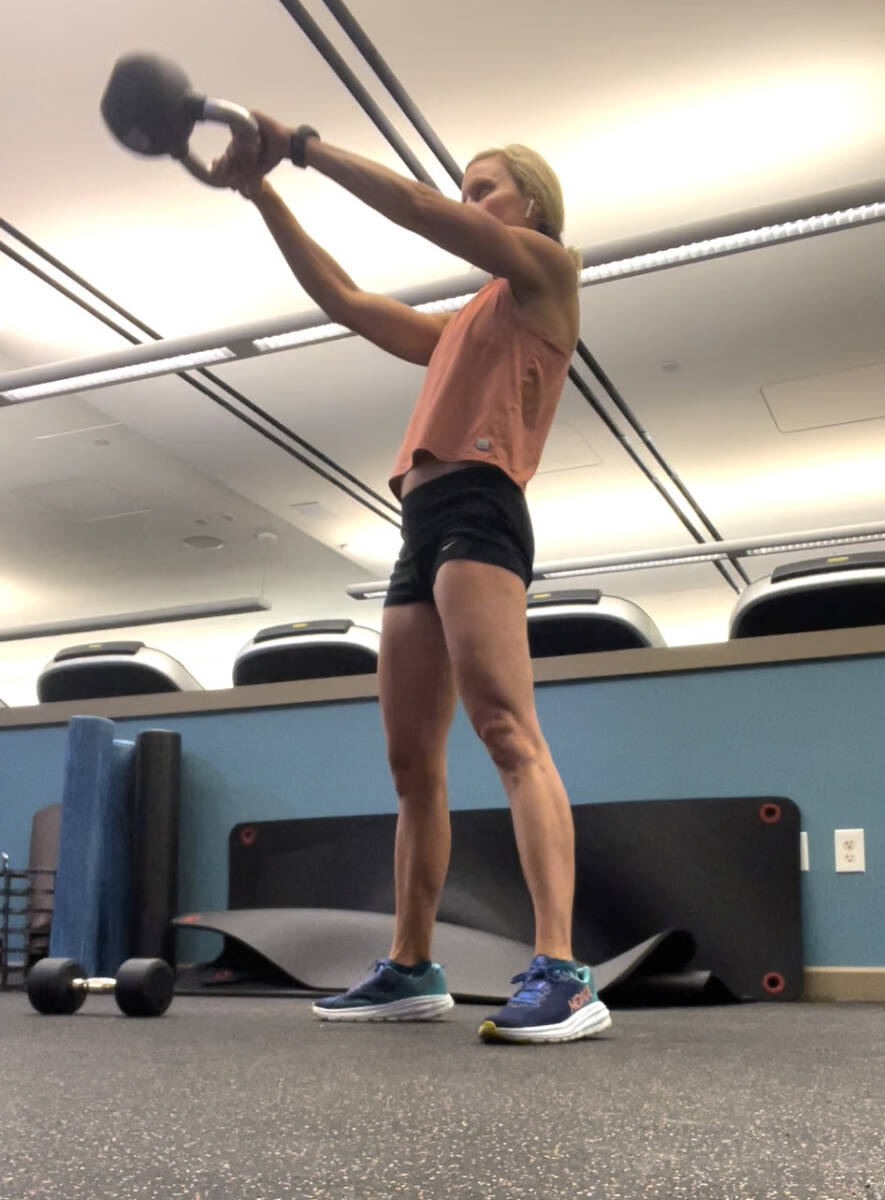
Related: Your Strength Training Guide for Runners
These kettlebell leg exercises specifically target the posterior chain—your hamstrings, glutes, back, and core all together—which is commonly weak in runners. This weakness can lead to injury and poor performance.
Funny enough, when I was thinking about writing this article, I left to visit my physical therapist. We discussed injury prevention as my training ramps up and his suggestion to me was, I need to strengthen my glutes to ensure they don’t tire too quickly and make my hamstrings pick up their slack. The best way to do this? A kettlebell leg workout.
So, I was then obviously sold I had to write this article to help other runners tap into this amazing resource. (And, sold I needed to incorporate kettlebell leg exercises more consistently into my strength training).
Related: Your Strength Training Guide for Runners
Table of contents
Let’s get going!
Why are kettlebells better than dumbbells?
It’s all in the shape. Kettlebells are better than dumbbells because their offset center of gravity forces you to engage your core when performing strength moves. When you hold the kettlebell, about six to eight inches away from your grip, it’s harder to control, recruiting your core to help.
Now, don’t kick your dumbbells to the curb. They still hold a place in your workout routine, but kettlebells pack a lot of power, and should definitely play a starring role in your lifting.
Related: Strength Routine for the Marathon: A Periodized Approach
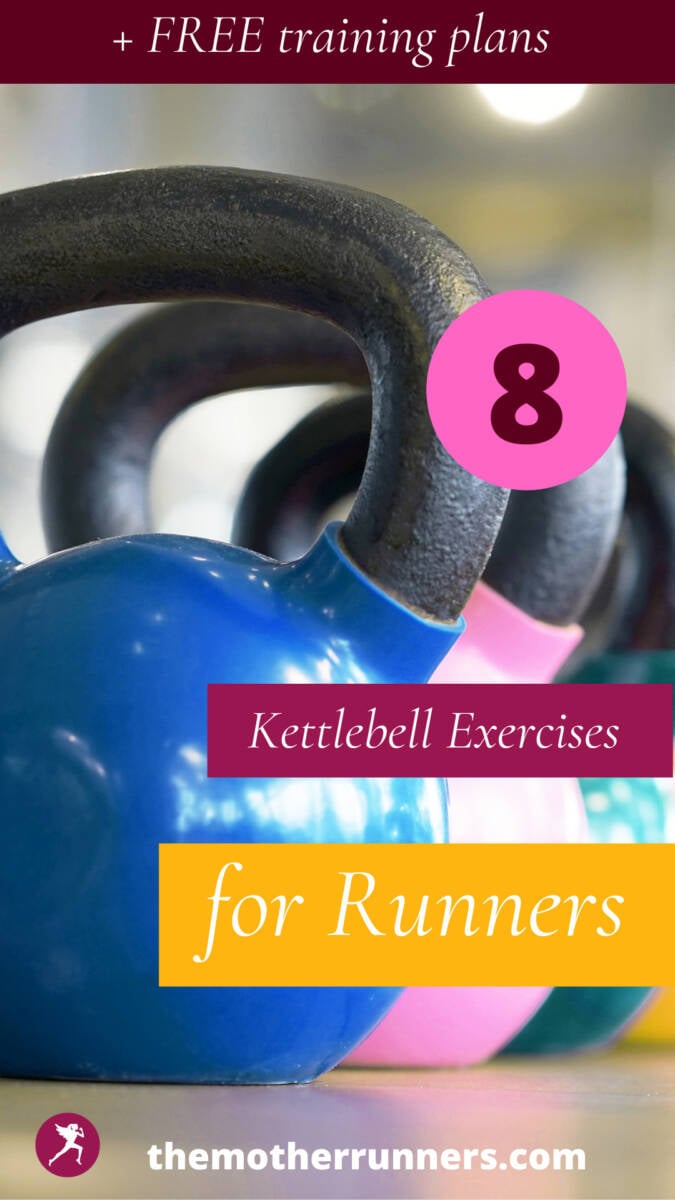
Why are kettlebells good for runners?
Kettlebell exercises are an effective and time-efficient way for runners to prevent injury and improve performance because they target areas commonly injured in runners.
“Kettlebells are proven to be a jack of all trades strength increasing oxygen uptake, explosive power, and working the entire body all in one,” explains Kaila Morgante, a movement specialist and certified running coach.
They work to strengthen the posterior chain along with your core which is often overlooked (but seriously important) in leg workouts for runners.
The benefits of kettlebell exercises for runners include improvement in:
- Overall strength
- Core stability
- Balance
- Range of motion
- Coordination
- Aerobic conditioning
In fact, several studies have shown that when people lifted kettlebells over other types of weights, they improved their core strength (by up to 70 percent), balance, and aerobic power. Also note, this kettlebell leg workout can be incorporated into a HIIT workout if desired.
Related: 7 Best Hamstring Exercises for Runners
Can kettlebells make me run faster?
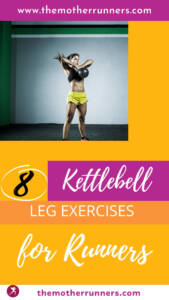
Yes, kettlebells can make you run faster. Kettlebell workouts strengthen your muscles giving you more power and they have been found to strengthen your cardiovascular fitness by increasing your VO2 Max (amount of oxygen uptake when running fast), too. A 2015 study of female athletes found an improvement of VO2 max of 6 percent after a month of kettlebell workouts. That improves your running performance and could mean a big PR!
Related: 9 Running Hacks to Make You Run Faster
Kettlebell Leg Workout for Runners
Kettlebells promise an effective and time-efficient way to get stronger and faster and prevent injury, so let’s stop wasting time and get to the kettlebell leg workout for runners!
The following kettlebell routine focuses on the lower body: hamstrings, glutes, quads, and core. These moves are not intended to be used altogether unless you really to punish your legs.
Instead, use this kettlebell leg workout as a sort of menu to pick and choose, and combine with other strength training moves.
Related: Free Strength Workout for Runners
For example, choose three kettlebell leg exercises, combine them with three upper-body moves such as wide push-ups, triceps dips, and a bent-over row; plus, three core movements like a plank jack, Russian twist, and boat pose, for a lovely strength training circuit.
Choose a weight that’s heavy but you can do about 7-10 reps with. Aim to do three circuits with 10 reps. Or, you can do these moves for time—aiming for one minute per move with a short 20-second rest in between so you maintain proper form.
Variety is the spice of life and the world is your oyster—and all those sayings—so mix it up to keep your body guessing!
Related: How I Stopped Being Injury Prone
1. Kettlebell Swing
The kettlebell swing is the mother of kettlebell leg exercises for runners as it targets the hamstrings, glutes, back, and core—all in one. Plus, it improves mobility which is key for efficiency in movement and injury prevention.
As Kaila notes, “Think about the muscles that dominate when we run – much of our power comes from propelling ourselves forward. The kettlebell swing focuses on the hip hinge, which zones in on the backside, or the posterior chain. The kettlebell swing is seriously essential.”
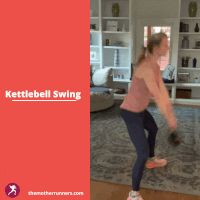
How to do a kettlebell swing:
- Start with the kettlebell on the floor about a foot in front of you and your feet hip-width apart.
- Reach forward to grab the kettlebell handle with both hands. Keep your back flat and hips up.
- Pull the kettlebell back between the legs. Keep your hips hinged and chest up.
- Quickly, squeeze your glutes to extend the hip forward. This will push your arms and kettlebell up above your hips. Breathe out as you do this.
- You will finish in a standing position. That’s one. Repeat.
2. Kettlebell Single Leg Deadlift
The single-leg deadlift is a standard strength move for runners. However, doing a deadlift with a kettlebell incorporates your core muscles, making it an even more powerful and rewarding move.
By doing a single leg movement, you promote unilateral stability which is key since the running leg gait cycle includes standing on one leg. It also targets the hamstrings and glutes which are crucial for running strength, power, and endurance.
How to do a single-leg deadlift:
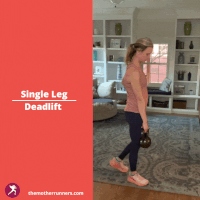
- Stand with a kettlebell in one hand.
- Hinge at the hips and ready the kettlebell towards the floor, lifting one leg on the side you’re lifting a weight and keeping both legs straight.
- Keep the muscles of the lifted leg engaged by squeezing the quad and flexing your foot.
- Ensure your back is flat, your standing knee is slightly bent, and your hips drive back to engage the standing leg’s hamstring and glute.
- After you tap the kettlebell to the floor (or however far down you can go maintaining a flat back), rise back up to a standing position with control.
Related: Plyometric Workout for Runners
3. Kettlebell Goblet Squat
The Goblet squat is another class kettlebell move for runners that targets the quads, hamstrings, glutes, core, and (bonus!) your arms. If you do this move right, you’ll like be pretty sore in your glutes and hamstrings. Go as low as you can without putting pressure on your low back.
How to do a kettlebell goblet squat:
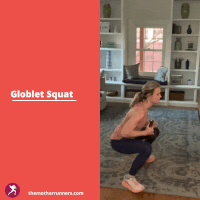
- Stand with your legs hip-width apart with your toes pointing forward.
- Place your hands on either side of the kettlebell handle and hold it in front of your chest.
- Push your hips back with your chest up as you lower to a squatting position. Your elbows should touch the inside of your knees.
- Squeeze your glutes and drive through your heels to return to standing. Repeat.
4. Kettlebell Side Lunge
When we run, we move in a single plane, the sagittal plane which moves forwards and backward. This can lead to muscle imbalances and leave us vulnerable to injury as we neglect muscles not used in this plane. This side lunge strengthens those neglected muscles giving us more stabilization as we run and also protecting us from injury in any movements made outside the plane.
How to do a Kettlebell Side Lunge:
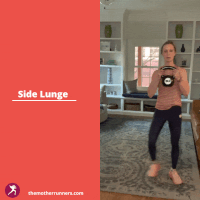
- Hold a kettlebell in front of you with both hands on the handle.
- Step sideways and bend the leg that steps out while keeping the opposite leg straight.
- Keep your chest up and shoulders back. Think of this movement as a squat on one leg, while stretching the other leg out straight.
- Drive into the bent leg to propel yourself back to the starting position.
5. Kettlebell Step-up
I love the kettlebell step-up for working the quads, glutes, and core stabilizers. It gives a great burn to all your leg muscles including your quads, glutes, adductors, calves, hamstrings, plus works your core, shoulders, traps, and upper back.
How to do a Kettlebell Step-up:
- You can use two kettlebells in each hand or pull one close to your chest to work your upper body.
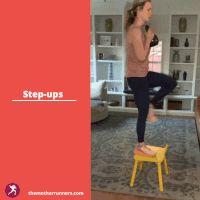
6. Kettlebell Overhead Lunge
This variation of the basic lunge works your hamstrings, quads, and glutes plus your full upper body, back, and core as they work to stabilize the weight.
When executing the overhead lunge with the kettlebell, make sure you keep the weight directly overhead. This means you need to keep in line with your shoulder joint. Then proceed to step back into the start of a lunge position.
How to do a Kettlebell Overhead Lunge:
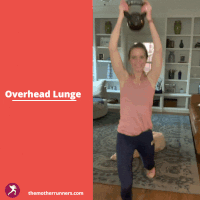
- Place your feet shoulder-width apart with your knees slightly bent and hold the kettlebell straight over your head.
- Take a step back and move into a deep lunge while keeping the kettlebell directly over your head and in line with your shoulders.
- Make sure your front knee remains over your forward foot. It should not go past your foot.
- Drive your forward heel into the ground as you move back up. Repeat.
7. Kettlebell Extended Leg Glute Lifts
This extended leg glute lift targets the side of your glutes which are important for stabilization as you run. It also improves the range of motion in your hip and strengthens your femoral neck, protecting you from hip injuries. These extended leg glute lifts work your glutes, hips, adductors, abductors, core, and back.
How to do a Kettlebell Extended Leg Glute Lift:
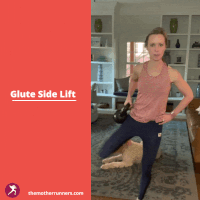
- Hold the kettlebell at your side by your hip while standing near a wall for stabilization as needed. Your feet should be shoulder-width apart.
- Bend your outer leg so that your knee is at 45 degrees.
- Lift your bent leg out to the side keeping your body square.
- Return to the starting position and repeat. Then switch sides.
8. Sumo squat
I know we already have a squat included but I had to add the sumo squat because it does a great job building your hips which play a starring role in your running gait. Goblet squats, conversely, focus more on your knees and quads.
In addition to working your hips, sumo squats work your glutes, hamstrings, adductors, and abductors.
How to do a Kettlebell Sumo Squat:
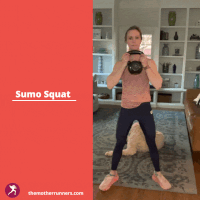
- Hold the kettlebell with both hands and stand with feet slightly wider than shoulder apart. Toes should be pointed out.
- Keep your weight on your back heels, chest forward, and push your hips into a deep squat position. Pull the kettlebell to your chest as you lower.
- Go until your thighs are parallel to the floor.
- Squeeze your glutes at the top, pause, and then return to starting position. Repeat.
Mix these kettlebell leg exercises in with traditional lifting using bodyweight, a rack and weights, dumbbells, and plyometrics to supercharge your running!
If you want a custom plan to fit your marathon goals with your busy schedule, check out my run coaching services. Also, be sure to check out my free training plans:
